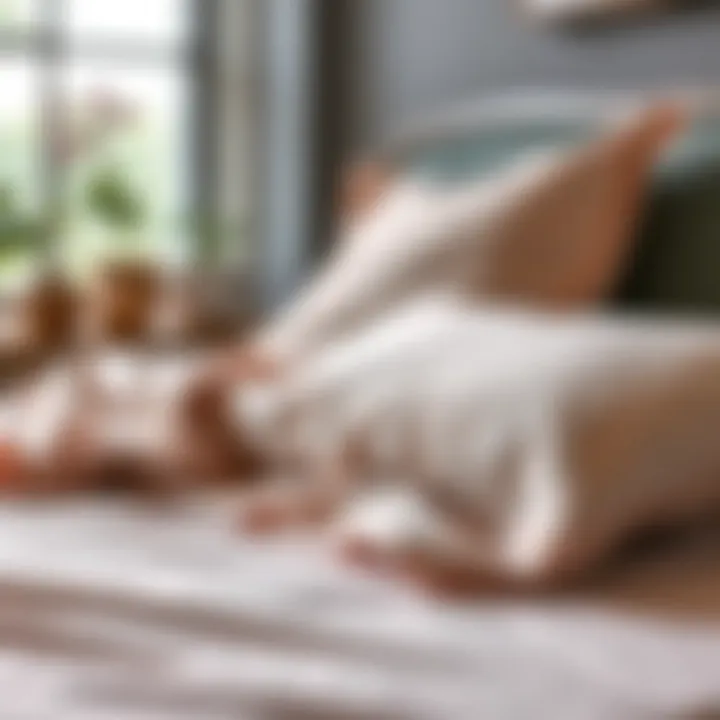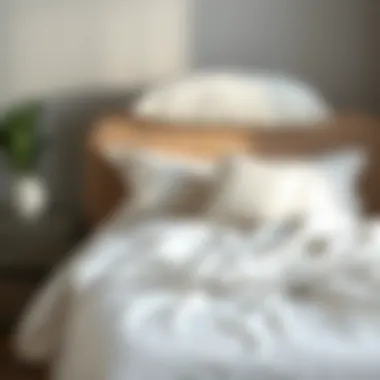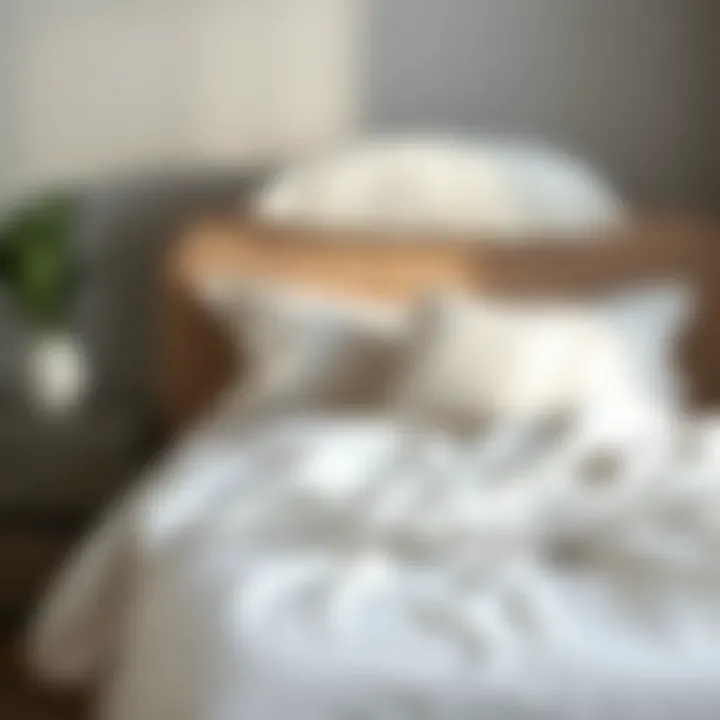Choosing Quality Queen Sheets for Supreme Comfort


Intro
When it comes to furnishing your bedroom with comfort and aesthetics, the choice of quality queen sheets often flies under the radar. Yet, these seemingly simple bedding essentials play a crucial role in enhancing your sleep experience. With a myriad of materials available, varying thread counts, and countless brands to consider, diving into the realm of queen sheets can feel overwhelming.
Understanding the impact of sheet quality on your overall well-being is paramount. Quality sheets can transform your bed into a haven of relaxation, providing not only comfort but also contributing to the visual appeal of your space. In this article, we will explore the essential factors to consider in selecting the right sheets—highlighting what makes them comfortable, durable, and a perfect fit for your bedroom.
Design Inspirations
As the heart of the bedroom, your bed deserves to be dressed in sheets that not only feel great but also reflect your personal style. Exploring design inspirations for queen sheets involves more than just functionality.
Trending Styles
Today’s bedding trends lean towards unique textures and artful designs. From classic looms to modern prints infused with vibrant colors, there’s a style to suit every taste:
- Farmhouse Chic: Neutral patterns with a rustic touch promote a cozy feeling in your haven.
- Minimalist Elegance: Solid colors and sleek, crisp sheets cater to those who prefer a clean and modern aesthetic.
- Bohemian Flair: Eclectic patterns and a mix of colors can add an artistic vibe to your bedroom.
These styles not only align with trends but also promote a comforting ambiance.
Color Palettes
Selecting the right color palette can make or break the energy in your bedroom. Here are a few suggestions:
- Earth Tones: Shades of brown, green, and soft yellows can create a warm, inviting space.
- Pastels: Light blues, soft pinks, and gentle greens foster a calming environment, perfect for restful nights.
- Bold Hues: Rich jewel tones like deep emerald or royal blue can serve as a striking focal point that elevates the entire room's appearance.
"Color in your bedroom can influence your mood and create a soothing atmosphere conducive to sleep."
Pairing these colors with matching or complementary decor elements can enhance the overall look of your space, keeping it both trendy and personal.
The End
Discovering the ideal queen sheets blends practicality with style. From design inspirations to smart material choices, knowledge is key in making informed decisions. Plenty more awaits as we delve into the practical matters of maintenance and care later in this article. Stay tuned!
Understanding Queen Sheets
When it comes to creating a sanctuary within your home, few elements hold as much significance as your bedding. Understanding queen sheets is foundational to both comfort and style in your bedroom. This section aims to illuminate how these sheets serve not just to cover a mattress but to enhance the quality of rest and contribute to the overall aesthetic.
Dimensions and Fit
Queen sheets typically measure 60 inches by 80 inches, making them the perfect fit for standard queen-sized mattresses. But dimensions encompass more than just measurements; they influence how well sheets stay in place during the night. A proper fit means fitted sheets hug the edges snugly without slipping, ensuring comfort throughout the night. If sheets are too big, they crumple and create an uncomfortable sleeping experience; if they are too small, they feel restrictive.
To test fit, consider the pocket depth if you own a thicker mattress or use a mattress topper. The pockets of your fitted sheets should ideally align with your bed’s height. Otherwise, they might pop off, leading to disrupted sleep. The beauty of queen sheets lies in their versatility, too; many brands offer deep pocket options, accommodating various mattress thicknesses. This attention to sizing can mean the difference between a restful night and a rolling struggle to reposition loose sheets.
Why Quality Matters
The quality of your queen sheets affects more than just how they look; it directly impacts your sleep health. Quality sheets are made from superior materials, which means they tend to be softer, more durable, and better at regulating temperature. In the long run, investing in quality sheets can save you money. Cheap sheets wear out faster, often leading to frequent replacements.
Moreover, high-quality sheets can even affect your skin health. Fabrics like cotton or bamboo allow for proper ventilation, reducing skin irritations and allergies. Unlike synthetic materials, breathable fabrics help maintain a comfortable sleeping temperature, which is crucial for deep sleep. In essence, taking the time to choose quality isn’t just about luxury or style—it's about investing in your well-being.
"Investing in quality queen sheets can vastly improve sleep quality, lending to better overall health and a more inviting bedroom atmosphere."
Materials of Quality Sheets
When considering queen sheets, the material plays a pivotal role in determining the overall comfort, durability, and aesthetic of your bedding. Materials not only influence how the sheets feel against your skin but also can affect the temperature, durability, and ease of care. Quality materials can elevate your sleeping experience, making it paramount to understand the options available in the market.
Cotton Varieties
Cotton is a staple fabric for sheets, and its type can significantly impact softness and durability.
Egyptian Cotton
Egyptian cotton is often touted as the gold standard for bed sheets. Its primary characteristic is its extra-long staple fibers, which result in finer threads that weave into a luxurious fabric. One of the key benefits of Egyptian cotton is its breathability, which helps in temperature regulation. This means that whether it’s a hot summer night or a cool winter’s eve, Egyptian cotton sheets will keep you comfortable.
However, it's essential to note that not all Egyptian cotton sold is equal. Authentic Egyptian cotton can be quite pricey, making it a luxury choice for many. Additionally, the maintenance may require specific washing instructions to retain its softness and longevity.
Pima Cotton
Pima cotton, another high-quality option, offers a similar softness and durability comparable to Egyptian cotton. Its fibers are also long and silky, giving it a soft, smooth finish on the skin. A highlight of Pima cotton is its natural resistance to fraying and fading, which contributes to its long lifespan. This makes it a beneficial choice for people looking for sheets that maintain their look and feel over time.
However, it's worth mentioning that true Pima cotton sheets can often carry a hefty price tag, which might not suit every budget. While the fabric is easier to care for, it also requires gentle washing to ensure that it keeps its quality.
Upland Cotton


Then there’s upland cotton, the most commonly grown cotton in the United States. This type features shorter fibers, which can make a difference in its overall feel and performance. While it is generally more affordable than Egyptian or Pima cotton, it doesn't quite reach the same level of softness or durability.
The unique aspect of upland cotton lies in its availability and cost-effectiveness. It is considered a solid option for those who prioritize affordability. However, buyers should keep in mind that the quality might not match higher-end cotton varieties.
Alternative Fabrics
For those seeking new options beyond traditional cotton, alternative fabrics are becoming increasingly popular in the bedding marketplace. These choices not only cater to diverse preferences but also contribute to various sleeping conditions.
Bamboo
Bamboo fabric has gained attention for its eco-friendly properties. Derived from the bamboo plant, this material is naturally moisture-wicking and breathable, making it an excellent choice for those prone to night sweats. A key feature of bamboo sheets is their soft texture, which feels sumptuous against the skin, rivaling even high-end cotton.
However, bamboo sheets can sometimes require special care during laundry to prevent damage, and their cost can vary significantly. While bamboo is sustainable, some manufacturing processes can compromise its eco-friendliness.
Microfiber
Microfiber is made from finely woven synthetic fibers, and it has surged in popularity due to its affordability and easy maintenance. The primary advantage of microfiber is its stain resistance and ability to dry quickly. This characteristic makes it a practical choice for households with kids or pets.
On the flip side, some may find microfiber less breathable than natural fibers, which can lead to discomfort for those who tend to overheat at night. It can also introduce more allergens and dust mites if not washed regularly.
Linen
Linen sheets, crafted from the flax plant, are known for their durability and unique texture. One of the key characteristics of linen is its ability to become softer with each wash, offering a distinct tactile experience over time. Linen is particularly valued for its breathability and moisture-wicking abilities, which makes it suitable for all climates.
The downside is that linen can wrinkle easily and may not appeal to those who favor a polished look. Prices can also be on the higher end, but many consider the investment worthwhile due to linen's longevity and luxurious feel.
The choice of material ultimately shapes not just the aesthetic of your bedding but also informs your sleep quality directly. Understanding these materials can help homeowners, interior design enthusiasts, and hosts make informed decisions that enhance their bedroom's comfort and style.
Thread Count Explained
Thread count is a phrase often tossed around in the bedding industry, but it can carry substantial weight in influencing your sheet choices. Understanding thread count can be somewhat akin to grasping the fundamentals of fine wines; it demonstrates a blend of quality and craftsmanship. When assessing bed linens, it's important to recognize that thread count reflects the number of threads woven into a square inch of fabric. This encompasses both vertical (warp) and horizontal (weft) threads.
Defining Thread Count
Imagine a delicate fabric being crafted with a certain number of threads. In total, if you weave 300 threads both up and down in one square inch, you end up with a 300 thread count sheet. You might think, "The higher the number, the better the sheets," and while there’s truth to that, it’s not the sole determinant.
A wise consumer ought to consider not only the number but also the type of threads and weave employed. For instance, a set of sheets with a thread count of 600 made from lesser materials may not feel as luxurious as a 400 count sheet crafted from Egyptian cotton. This misbelief is similar to investing heavily in a fancy bottle of wine only to realize it’s not your taste at all.
How Thread Count Affects Quality
When it comes to quality, thread count plays a significant role, but it isn’t the entire story. Sheets boasting high thread counts don’t automatically equate to a good night’s rest. While a high count can indicate a denser, more durable fabric, it may also indicate that thread manipulation has taken place to inflate the number without necessarily improving the quality.
Considerations include:
- Feel: Higher thread counts may feel softer, yet a balance with the fabric type is still essential.
- Durability: Fabrics that are packed densely might last longer, given their resistance to wear and tear.
- Breathability: Sometimes, an exceedingly high thread count can lead to reduced airflow, making sheets feel stuffy or overly warm.
In essence, a higher thread count might suggest increased comfort, but it becomes critical to consider the overall material and weave in conjunction. Like mixing spices in a recipe, the elements must blend harmoniously for the ultimate experience.
"When purchasing sheets, remember: it's not just about the count but how all elements come together."
For more insights into bedding, check resources like Wikipedia or Britannica.
Choosing the Right Weave
When it comes to queen sheets, the weave can greatly affect not just the aesthetic appeal, but also the comfort and durability of the sheets. Think of the weave as the foundation of your sleeping experience; it plays a crucial role in how the fabric feels against your skin, how well it breathes, and how long it will last. Selecting the right weave can be the difference between a sleepless night and a restful slumber.
The two most common weaves you’ll encounter are percale and sateen. Each offers its own unique advantages and drawbacks, shaped by the method of construction and the materials used. Let's delve into these options and see how they stack up against each other.
Percale vs. Sateen
Percale, often hailed for its crisp feel, is a simple one-over, one-under weaving method. This results in a lightweight fabric that feels smooth and breathable. Percale sheets are cool to the touch, making them a great choice for those who tend to sleep hot or live in warmer climates. They tend to be more durable, withstanding multiple washes while retaining their fresh, starched appearance.
On the flip side, sateen is woven in a three-over, one-under pattern, giving it a luxurious, silky finish that feels plush against the skin. This weave tends to gather heat, making it a cozy option for colder nights. However, it may not breathe as well as percale, potentially leading to increased warmth during the night. Sateen sheets also have a tendency to wrinkle less than percale, which can be a charming quality for those who prefer a more polished look to their bed linens.
Ultimately, the choice between percale and sateen hinges on personal preference. Each weave offers distinct tactile experiences and has its own unique benefits that cater to different sleeping preferences.
Benefits of Each Weave
Both percale and sateen have their merits that can significantly enhance your sleep quality:
- Percale Sheets:
- Sateen Sheets:
- Breathability: Ideal for warm sleepers, allows air circulation.
- Crisp Feel: Offers a refreshing, cool sensation.
- Durability: Withstands wear and tear effectively.


- Luxurious Texture: The silky feel is akin to high-end hotel linens.
- Warmth: Provides extra coziness during chilly nights.
- Low Wrinkle: Maintains a smooth appearance with minimal effort.
No one weave reigns supreme; it all boils down to what you value most in your sleep experience. Whether you choose the cool crispness of percale or the decadent softness of sateen, understanding these options can guide you toward a more restful night’s sleep.
"Selecting quality sheets is not just about comfort. It's also about personal preference and lifestyle needs."
By knowing about these weaves, you can make a decision that aligns with your specific sleeping environment, preferences, and aesthetic considerations.
Top Brands for Quality Queen Sheets
Choosing quality queen sheets is not just about comfort; it's about finding the right brands that embody durability, style, and value. The importance of brand lies in the reputation they’ve built over time and their commitment to offering products that enhance the sleep experience. When you invest in sheets from a trusted name, you are usually assured of quality materials, thoughtful design, and reliable customer service, which all contribute to a better night's sleep and an elevated aesthetic for your bedroom.
Luxury Options
Mulberry Park Silks
Mulberry Park Silks is a standout when it comes to luxury sheets. Known for their exquisite silk fabric, they offer a unique blend of comfort and elegance. The silky smooth texture not only feels good against the skin but also helps to regulate temperature, keeping you cool in summer and warm in winter. One of the key attributes of Mulberry Park Silks is the range of vibrant colors and patterns they offer, making them a favored choice for those looking to add a touch of sophistication to their bedroom. However, one must consider that silk requires special care to maintain its luster, which can be a disadvantage for some.
Sferra
Sferra has carved a niche in producing some of the finest linens available on the market today. Their sheets often feature a higher thread count, which translates to a fabric that is both soft and durable. The brand prides itself on using high-quality cotton sourced from around the globe, ensuring that each product meets rigorous standards. A unique feature of Sferra sheets is their timeless designs that blend classic aesthetics with contemporary touches. While their pricing reflects the premium nature of the materials, many customers feel the investment is justified given the longevity and luxury of the products.
Frette
Frette is synonymous with luxury, often found in five-star hotels and high-end boutiques. What sets their sheets apart is the artisanal craftsmanship that goes into each piece. The brand emphasizes not just the fabric’s quality but also the artistry in the weaving process, resulting in sheets that are meant to be both functional and beautiful. A distinctive element of Frette sheets is their variety of textures, offering options that range from crisp percale to sumptuous sateen. The downside, perhaps, is the price point, which might make it less accessible for average consumers wanting a taste of luxury.
Affordable Yet Quality Choices
Brooklinen
Brooklinen offers a refreshing approach to bedroom linens with a perfect balance of quality and affordability. The brand is known for its direct-to-consumer model, cutting out the bulging retail markups. One of Brooklinen’s hallmarks is its commitment to high-quality cotton that is soft yet durable. They have a variety of patterns as well as solid colors, appealing to a wide range of tastes. The downside is that while they are highly regarded, some users have reported that their longevity can sometimes fall short compared to pricier brands, but many would argue they provide exceptional value for the price.
Casper
Casper, well-known for their mattresses, has also entered the sheet market with a promise of comfort. They offer sheets that are crafted with a unique blend of materials aimed at enhancing breathability and softness. With a focus on modern design and functionality, Casper’s sheets fit seamlessly into any bedroom decor. Plus, their commitment to sustainability is a bonus for eco-conscious consumers. One drawback is that the limited range of colors might not cater to all aesthetic preferences, but the quality often compensates for this.
Target's Threshold Line
Target's Threshold Line offers a surprisingly high-quality option at an accessible price point for those on a budget. With a variety of patterns and colors, these sheets appeal to a wide demographic. They're made with materials that feel comfortable and hold up well in the wash. While they might not have the luxurious touch of high-end brands, customers appreciate their affordability and the value they bring to everyday use. The trade-off here may be in the longevity and ultimate softness compared to more expensive options, but for many, they are a reliable and stylish choice.
In summary, selecting quality queen sheets is a balancing act between luxury and affordability. Each brand mentioned offers unique advantages, whether it’s exquisite comfort or budget-friendly options. Understanding these differences is crucial for making an informed decision.
Care and Maintenance of Queen Sheets
Taking care of your queen sheets might seem routine, but it plays a vital role in their lifespan and your comfort. Proper maintenance ensures that your sheets remain soft, breathable, and free from allergens, directly impacting your sleep quality. Quality sheets can be quite an investment, and maintaining them effectively will let you enjoy their benefits for years instead of mere months. Regular washing, mindful storage, and understanding the right methods of caring for your sheets can significantly enhance your overall bedding experience.
Washing Instructions
When it comes to washing sheets, most people might think there’s just one way to go about it; however, there are a few nuances that can make all the difference. The general recommendation is to wash your queen sheets every one to two weeks, but how you do it is what counts.
- Temperature Matters: Use cold to warm water for delicate fabrics but consider hot water for cotton sheets. Hot water can help remove dirt and dust mites without damaging quality fabric.
- Detergent Choice: Opt for a gentle detergent. Not all detergents are made equal, and sometimes harsh chemicals can wear down the fibers, leaving your sheets feeling rough against the skin.
- Avoiding Fabric Softeners: Although fabric softeners may seem like a luxury, they can leave residues that inhibit breathability and moisture-wicking properties, ultimately working against you.
- Drying Procedure: If you have the option, air drying can prolong the life of your sheets. However, if using a dryer, select the low heat setting to reduce the risk of fabric shrinkage and maintain softness.
Following these washing practices can help your sheets keep their luxurious feel while extending their life. Paying attention to these instructions can prevent fading and maintain the overall integrity of the material.
Storage Tips
Understanding how to store your queen sheets properly is just as important as washing them right. Improper storage can lead to wrinkled, musty smelling sheets that feel less inviting on your bed. Here’s how to do it right:
- Keep 'Em Cool and Dry: Store sheets in a cool, dry place to inhibit the growth of mold or mildew. A breezy cupboard or a spare drawer is ideal. Using breathable fabric bags can also help protect sheets from dust.
- Fold Carefully: Instead of cramming sheets into a drawer, take the time to fold them neatly. A good fold helps to minimize wrinkles and keeps the fabric looking fresh.
- Avoid Overpacking: Don’t squish sheets into an already stuffed space. Overpacking can lead to creases and can harm the fabric fibers. Leave some breathing room; it’ll be worth it.
- Organizing by Set: Keep sheet sets together. Consider placing pillowcases inside the corresponding fitted and flat sheets; it’s helpful for quick access and helps avoid losing pieces in the clutter.
Exercising proper storage habits ensures convenience and keeps your bedding fresh and inviting.
"Quality sheets are not just about being soft—they’re an investment in your well-being and sleep hygiene."
Impact on Sleep Quality
When it comes to your sleep environment, the right bedding can make all the difference. Choosing quality queen sheets isn’t just about aesthetics; it’s about creating a sanctuary that promotes healthy sleep patterns. In this exploration, we’ll dive into how the comfort and health considerations tied to sheets can drastically improve the quality of your rest.
Comfort Factors
Temperature Regulation
Temperature regulation plays a pivotal role in our overall comfort during sleep. High-quality sheets made from breathable materials like cotton or linen can wick moisture away from the body, helping to keep you cool in warm months and warm in colder weather. This characteristic becomes especially crucial for those who tend to overheat at night, creating an environment conducive to restful sleep.


A unique feature of sheets that excel in temperature regulation is their ability to enhance air circulation. This means that rather than feeling stuffy or trapped under layers of fabric, the body can comfortably maintain its natural temperature throughout the night. In the context of this article, sheets that effectively manage temperature tend to rank higher in user satisfaction and sleep quality.
Softness
Softness is another critical aspect that can affect the quality of various sheets. The tactile experience of your bedding can create a significant psychological effect; slipping into sheets that feel luxurious and soft can set the tone for a good night’s sleep. Materials like Egyptian cotton are celebrated for their silky feel, which many find to be inviting.
However, it’s worth noting that softness comes with varying degrees. While some fabrics might feel plush, they may also carry a risk of wear or pilling over time. In this regard, understanding how to maintain softness in sheets enhances their longevity and overall experience, thus elevating your sleep quality.
Health Considerations
Allergies
For those suffering from allergies, choosing the right sheets can be a game-changer. Allergic reactions can be triggered by dust mites, pollen, and other allergens that accumulate in bedding. High-quality, hypoallergenic sheets can significantly minimize exposure, providing a healthier sleeping environment. These sheets are typically made from materials less likely to harbor allergens or irritants.
The key characteristic here is the weave and treatment of the fabric. For instance, tightly woven materials can deter dust mites more effectively than loosely woven ones. By selecting sheets designed with allergy sufferers in mind, you're not only investing in comfort but also in your health—reducing sneezing, itching, and other discomforts.
Skin Sensitivity
Living with skin sensitivities demands a careful selection of materials, as irritations can disrupt peaceful rest. Soft, breathable fabrics minimize friction against delicate skin, contributing to a more comfortable sleep experience. Organic and chemical-free sheets are often recommended in these cases, as they reduce the risk of skin irritation or reactions caused by synthetic materials.
A unique feature of sheets that cater to skin sensitivity is their gentle touch. Look for options that boast certifications for organic production or chemical-free processes. These sheets not only promote a healthier sleep environment but can also soothe sensitive skin, making them a popular choice for discerning shoppers seeking comfort without compromising their skin’s health.
Buying Considerations
When it comes to queen sheets, there’s a lot more at play than simply choosing a pretty color or fun pattern. Buying considerations encompass several factors that influence both the immediate satisfaction and long-term enjoyment from your bedding. These thought-provoking decisions can affect not just your pocketbook but also your overall quality of sleep and the aesthetic of your room. So let’s dive into the key aspects of buying considerations that every consumer should keep in mind when looking for their perfect queen sheets.
Budgeting for Quality
Setting a budget is a critical first step when hunting for quality queen sheets. It’s tempting to go for the cheapest options, especially when numerous establishments offer budget bedsheets. However, the adage "you get what you pay for" rings truer than ever in the bedding industry. Quality sheets crafted from fine materials can resist wear over time – meaning they won�’t fray or lose their appeal after a few washes.
- Long-term Investment: Spending a bit more upfront on durable sheets could save you in the long run.
- Comfort and Sleep Quality: Higher-quality sheets generally feature better thread counts and materials, leading to improved sleep quality.
- Health Considerations: Lower-cost sheets may contain chemicals or untested materials that can affect skin sensitivity and overall well-being.
While it’s possible to find good deals, a balanced approach – where aesthetics, quality, and budget align – is paramount. Don’t shy away from mid-range options that pack a punch in durability and feel.
Where to Buy
Finding the right place to source your queen sheets is as essential as the sheets themselves. There are two main categories worth exploring: online retailers and department stores. Each option has its unique benefits, and understanding these can make a world of difference for the savvy shopper.
Online Retailers
Online retailers have made shopping for queen sheets incredibly convenient. One significant aspect of online shopping is accessibility – you can browse selections from the comfort of your home without being overwhelmed by store noise or salespeople.
- Wide Selection: One of the most pronounced characteristics of online shopping is the sheer variety available. You can easily filter by material, thread count, or price, allowing you to find exactly what you want without the hassle of navigating crowded aisles.
- Convenience: You can take your time comparing reviews and prices across multiple platforms, ensuring that you make a well-informed choice.
- Unique Features: Many online retailers often offer user reviews and recommendations, giving you insight into the products from actual customers. However, a potential downside could be the inability to feel the fabric before purchasing.
Department Stores
Department stores provide a classic shopping experience that carries its own unique advantages. When considering department stores for your queen sheets, the tactile experience stands out.
- Hands-On Experience: You have the chance to feel the texture of the sheets firsthand, assuring yourself of their quality before you buy. There is nothing quite like running your fingers through the material.
- In-Person Assistance: Having staff available to guide your selection can benefit those who may feel overwhelmed by options. They can lend insights based on your specific needs or preferences.
- Promotions and Sales: Sometimes, department stores hold sales which can make purchasing higher-quality sheets more approachable. The downside can be a limited selection compared to online stores.
Choosing where to buy your queen sheets can shape your overall purchasing experience, satisfaction, and understanding of the product. Each shopping method has its strengths – embracing these can make all the difference in your quest for the ultimate sleeping experience.
Trends in Bedding
In the realm of home textiles, trends in bedding can tell you a great deal about personal style and preferences. This section seeks to uncover the importance of keeping an eye on these trends. Bedding isn't just about functionality; it also plays a crucial role in defining a space's aesthetic and comfort.
Often overlooked, the choice of bedding can elevate the overall ambiance of a bedroom. Current trends reflect a blend of comfort, sustainability, and style. These elements not only cater to the needs of modern homeowners but also appeal to those with an eye for design and quality.
Popular Patterns and Colors
When it comes to patterns and colors, the world of bedding is bursting with options. From muted earth tones to vibrant botanical prints, the choices are endless. Here are a few trending patterns and colors:
- Geometric Designs: These can add a modern touch to your bedroom, providing a clean yet dynamic look.
- Floral Prints: Always in season, floral patterns can soften a space, inviting warmth and vibrancy.
- Solid Pastels: Soft hues like mint green or blush pink are perfect for creating a serene environment.
- Bold Jewel Tones: Deep colors like emerald and sapphire are gaining popularity, adding flair and luxury.
One must remember that the chosen patterns and colors can influence not just the visual aspects of the bedroom, but also emotional responses. Cool colors can evoke calmness, while warmer tones create an inviting atmosphere.
"The right bedding can turn a simple bedroom into a sanctuary."
Sustainability in Bedding Choices
Sustainability is a buzzword that has resonated well in recent years, especially in the bedding industry. Consumers are becoming more conscientious about their purchases, focusing on how options align with their values. Choosing sustainable bedding contributes not just to personal comfort but also promotes environmental health.
Below are some considerations when exploring sustainable bedding options:
- Organic Materials: Look for sheets made from organic cotton or linen. These fabrics are grown without harmful pesticides, making them better for both you and the planet.
- Recycled Materials: Some companies are using recycled fibers to create bedding, reducing waste and encouraging a circular economy.
- Certifications: Be on the lookout for certifications such as GOTS (Global Organic Textile Standard) which ensures that products are genuinely organic and produced under environmentally friendly conditions.
Embracing sustainable bedding does not mean compromising on quality or style. In fact, many brands are proving that eco-friendly products can be just as luxurious as conventional materials, often fastening the trend in the hearts of design enthusiasts.
As homeowners and design aficionados, staying attuned to these trends in bedding can facilitate more informed, aesthetically pleasing, and sustainable choices in one’s bedding selections.







